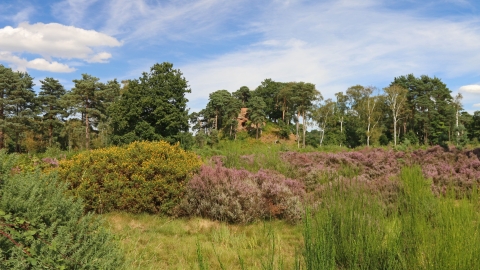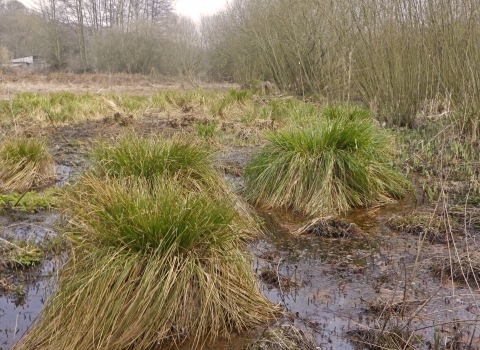If you've visited recently, we'd really appreciate it if you could complete our short survey about your visit. Thank you.
Follow our Saving Worcestershire's Heathlands journey to create the biggest block of heathland in the county.

The Devil's Spittleful by Wendy Carter
The Devil's Spittleful and Blackstone Farm Fields
Location
Know before you go
Dogs
When to visit
Opening times
Dusk to dawn on The Devil's Spittleful. No access to Blackstone Farm Fields.Best time to visit
All year roundAbout the reserve
This impressive heathland is one of the largest areas of the habitat left in Worcestershire; it’s estimated that we’ve lost approximately 90% of heathland in the county over the last 200 years.
Visitors walk through a mosaic of habitats that thrive on acid soil; open areas are dominated by bell heather and acid grassland is dominated by wavy hair grass.
Heaths were traditionally managed to provide grazing for livestock and many useful materials such as bracken for bedding, birch for brooms, kindling and firewood. When farming practices changed, heathlands were generally abandoned as they are not productive by modern farming standards. Since the 1950s this site gradually became dominated by scrub and young trees. We are reversing this and now graze the site and manage the scrub and tree cover. Grazing helps the regular management of gorse, broom and silver birch. This provides different ages of plant, which is great for supporting a diverse group of wildlife whilst allowing the heathland to improve and expand.
The heather is at its best in late July and August but there are many other plants to discover - heath dog violet, early forget-me-not and small cudweed are in flower from June to September. Grey hair grass and buck’s-horn plantain are also found on the reserve; they’re normally associated with coastal regions.
The combination of heathland, grassland, scrub and trees is perfect for invertebrates. 20 species of butterflies can be spotted – from pearl-bordered and silver-washed fritillaries to purple hairstreaks. More than 160 species of moth have also been recorded here included barred tooth striped, grass wave, orange underwing and fox moth. The reserve is great for bees and wasps and is known for three important species: the black mining bee Andrena nigrospina, a colony of Lasius fuliginosus ants and the hornet robber fly Asilus crabroniformis. The reserve is also great for fungi, with over 140 species including pine wood mushroom, oyster mushroom and liberty cap. Visitors should keep a look out for redstart, tree pipit, cuckoo, yellowhammer, lesser whitethroat, green woodpecker and sparrowhawk.
The reserve gets its name from the rocky sandstone knoll crowned with Scots pine. It is known as The Devil’s Spittleful or Spadefull; a ‘spit’ was a spade’s depth and the area is thought to have got its name from a digging Diablo. The cave beneath the rock has become unstable and is now no longer safe to view.
We bought the neighbouring Blackstone Farm Fields in 2007 and are gradually returning them to heathland. It's a long process but as heathland-loving plants thrive in poor quality soil, we've begun by reducing nutrient levels. In 2021 we bought adjacent Dropping Well Farm, which we are starting to restore to heathland. Buying this patch of land will help to create a block of 300 acres of heathland and 600 acres of mixed habitat. The adjacent Rifle Range and Burlish Top nature reserves are owned and managed by Wyre Forest District Council.
Bigger, better and more joined up
We believe that a landscape-scale approach to wildlife conservation is essential. Wildlife needs space to adapt and move to cope with the consequences of climate change. Practically, this means that we need our countryside to be bigger, better and more joined up to provide a coherent network of large areas linked by corridors that can provide benefits for people as well as for biodiversity.
This is an important heathland site with extensive restoration and creation taking place and is an ideal place where we can share our experiences of the long-term management of heathland and its creation and management of associated nationally important flora and invertebrates. The reserves fall within the Wyre Forest Heathlands identified as one seven priorities in Worcestershire for its Living Landscapes approach.
Species
Habitat
Contact us
Environmental designation
Location map
Become a member
If you enjoy visiting our nature reserves, join us today to help us manage and protect them.

